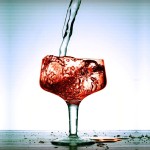Context is the key to understanding the meaning of water in John 3:5.
I tell you the truth no one can enter the kingdom of God unless he is born of water and the Spirit.
But John 3:5’s context extends far beyond Jesus’ conversation with Nicodimus. In all, there are 12 scenes involving water in John, of which the overwhelming majority are unique to John alone. From Jesus changing water into wine to the washing of His disciples’ feet, each plays an important role in revealing the water’s intended meaning.
In this post, I want to show you how John in part defines the meaning of water by creating features common to these scenes.

Common Element #1:
Something Jesus supplies is said or shown to be greater than water.
John the Baptist’s Testimony (1:19-34): Jesus baptism in the Holy Spirit is said to surpass John’s water baptism. John states three times that he baptizes in water (1:26, 31, 33). In each, he contrasts his water baptism with the supremacy of the one to come.
Jesus Wedding Miracle (2:1-11): Jesus’ “water-turned-wine” is better than the choice wine/water which came before. John establishes a subtle connection between wine and water. Although the wedding has run out of wine, Jesus fills not the empty wine jars but six water jars with water. Jesus of course surpasses the water by transforming it into wine but the headwaiter also testifies that his wine surpasses event that which preceded it.
Jesus Conversation by the Well (4:4-26): Jesus’ living water is greater than Jacob’s water. When Jesus offers the Samaritan woman living water she responds by asking if he he is “greater” than Jacob who gave them the well. By contrasting the limitations of the well water with the never-ending water he supplies, Jesus affirms He is.
His Healing by the Pool of Bethesda (5:1-9): Jesus’ healing is greater than the stirred water of the pool. While the man looks to the water to heal him, he is powerless to reach it. Jesus turns the mans attention to himself, telling the man to pick up his mat and walk. Because Jesus reaches the man at his need, His power is revealed to be greater than the stirred water’s of the pool
Jesus’ Invitation to Drink (7:37-39): Jesus “living water” is greater than the feasts water ceremony. Jesus invitation occurs on the last day of the Feast of Tabernacles. On this day the High Priest poured out water in the temple as a symbol of the later day river that would flow from the temple (Ez. 47:1-12; Zech. 14:8). Jesus’ invitation and reference indicates that he is the scriptures true fulfillment.
Common Element #2:
While each scene varies as to the source of water (i.e. baptism, waterpot, well, pool) all are united in connecting water with ritual and tradition.
John the Baptist’s Testimony (1:19-34): Water is the medium of baptism – a more or less traditional ritual of purification. While John’s baptism may be unique in that it is a one-time event, such water rituals were common in the first century Judaism.
Jesus Wedding Miracle (2:1-11): The water which becomes wine is drawn from containers used for ritual purification. This is important. Though Jesus could have reused the empty wine jars, he instead has the servants fill six waterpots which John tells us were “set there for the Jewish custom of purification.”
Jesus Conversation by the Well (4:4-26): The Samaritan woman’s well is a traditional site analogous to the Samaritan’s worship on the mountain. The woman points to the greatness of the well by pointing to the tradition that “father” Jacob had dug and drank from it himself. The word “father” is again used when the topic of conversation moves from well to worship. Just as ‘father” Jacob gave the well, the Samaritan “fathers” had given them worship on the mountain.
Jesus’ Healing by the Pool of Bethesda (5:1-9): The waters of Bethesda are a traditional site of healing. While the tradition mentioned in 5:3 may not be original to John’s gospel, it indicates a need to explain the man’s prior belief in the water. Such a tradition appears to be in line with connection made in the previous accounts.
Jesus Invitation to Drink (7:37-39): Jesus invitation to drink corresponds to the time and place of a well known water ritual. Though not specifically mentioned in the text, the above instances suggest that once again a water ritual is in view.
Conclusion
By contrasting water with what Jesus supplies, John reveals Jesus’ supremacy over ritual and tradition.
What do you think?

















Pingback: The Gospel Story You’ve Never Associated with Christmas (But Should) | Logos Made Flesh